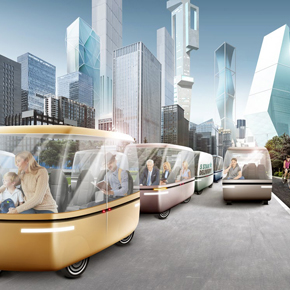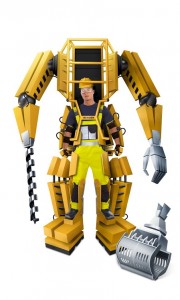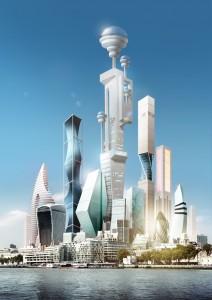
Back to the Future of Construction: Space ports, exoskeletons and virtual reality
To celebrate the 30th anniversary of Back to the Future, futurologist Ian Pearson has taken a trip a further 30 years down the line to predict what the world of construction may look like in 2045.
2045: Constructing the Future predicts a world of superhuman AI; half-human, half-machine exoskeletons and self-driving transportation ‘pods’.
Constructing the Future
Manufactured using ultra-strong, carbon-based materials, his report predicts that buildings will utilise advanced AI to adopt their very own personalities.
‘Smart buildings’ will collect and process sensor data, and help maintain all the various infrastructure and human comfort systems within the structure.
Advances in 3D printing will allow for the rapid construction of basic structures, and the extensive use of carbon nanotubes and graphene to reinforce building materials will enable stronger, lighter and taller buildings.
The tallest skyscrapers – up to 30 km tall – will act as mini-cities, many of which will house their very own space ports as space travel becomes a popular method of transportation.
Virtual architecture
As the use of augmented reality becomes more widespread, Ian suggests that it will greatly impact the visual appearance of our surroundings.
By 2045 we could see most buildings become windowless, instead featuring a simple planar surface, with more intricate details projected through the use of augmented reality. This way a cheap building can appear exactly the same in AR as an expensive one.
Virtual reality will also introduce marketing campaigns, artificial plants and animals into our surroundings to stimulate the visual environment.
Half human, half machine
The report speculates that most construction work will be completed with the use of super-strength exoskeletons.
Exoskeletons will convert builders into ‘transfomer-like’ workers, capable of lifting heavy loads and attaching special equipment to complete difficult tasks.
The heavy machines will work with a variety of attachments, including shape shifting technologies to help cut through materials, making cleaner edges and surfaces.
Augmented reality will also be utilised to allow the builders to see exactly where things should go and what the finished project is meant to look like to ensure the job is completed properly.
Transportation pods
Self-driving cars, similar to those currently being developed by Google, will be used universally by 2045 and almost entirely fleet managed, with private ownership rendered obsolete.
The electric vehicles will greatly reduce financial costs, pollution, congestion and accidents.
Vehicles, or ‘pods’, will be developed with the ability to share energy preserves, reducing their environmental impact and the need for external power sources.
Whilst these pods won’t hover, in special high-impact areas some vehicles may levitate on magnetic cushions, requiring partly metal road surfaces.
Back to the Future
Ian’s report concludes by suggesting that construction in 2045 will still share many of the same goals the industry faces today. Whilst automation and robots will be the biggest changes, the continued development of 3D printing and augmented reality will also have a significant effect on the way the industry operates.
Whilst we’re still waiting on some of the things promised in Back to the Future, the 2045: Constructing the Future report gives us plenty more to look forward to in the next three decades of construction.
Read 2045: Constructing the Future in full here
Latest news

19th April 2024
ASSA ABLOY: Access solutions can impact sustainability performance across the full life-cycle of a building
Embedding sustainability within any organisation requires a broad, strategic perspective. Scrutiny should include the physical infrastructure itself: According to the IEA, buildings consume around 30% of global energy*. ASSA ABLOY has more…
Posted in Access Control & Door Entry Systems, Architectural Ironmongery, Articles, Building Industry News, Building Products & Structures, Building Regulations & Accreditations, Building Services, Case Studies, Doors, Facility Management & Building Services, Information Technology, Research & Materials Testing, Retrofit & Renovation, Security and Fire Protection, Sustainability & Energy Efficiency, Video of the Week
19th April 2024
British weather doesn't dampen spirit for new HMG Garden Paint
Despite one of the wettest starts to the year on record, customers are starting to plan for brighter days with HydroPro Garden Paint from HMG Paints.
Posted in Articles, Building Industry News, Building Products & Structures, Garden, Innovations & New Products, Paints, Paints, Coatings & Finishes, Restoration & Refurbishment, Retrofit & Renovation, Site Preparation, Sustainability & Energy Efficiency, Waste Management & Recycling
18th April 2024
Abloy UK showcases new digital portfolio at The Security Event 2024
Abloy UK is set to unveil its latest line-up of access control systems at The Security Event 2024, welcoming guests to explore its cutting-edge electromechanical and digital solutions on stand 5/F50.
Posted in Access Control & Door Entry Systems, Architectural Ironmongery, Articles, Building Industry Events, Building Industry News, Building Products & Structures, Building Services, Doors, Exhibitions and Conferences, Facility Management & Building Services, Health & Safety, Information Technology, Retrofit & Renovation, Security and Fire Protection
18th April 2024
Strand is a Failsafe Choice for Emergency Exit and Panic Hardware
In times of emergency, you’re in safe hands with Strand Hardware. Although there are many considerations for building specification, few decisions can be as critical as selecting the right emergency exit/panic hardware.
Posted in Access Control & Door Entry Systems, Architectural Ironmongery, Articles, Building Industry News, Building Products & Structures, Building Services, Doors, Facility Management & Building Services, Health & Safety, Restoration & Refurbishment, Retrofit & Renovation, Security and Fire Protection
 Sign up:
Sign up: 